Smart Investor: 4 options strategies to enhance your Nike investments post-earnings
Options are complex, high-risk products and require knowledge, investment experience and, in many applications, high risk acceptance. We recommend that before you invest in options, you inform yourself well about the operation and risks.
4 options strategies to enhance your Nike investments post-earnings
Nike's Q1 2025 earnings report: a mixed bag
Nike recently reported its fiscal first-quarter earnings for 2025, which yielded a mixed outcome for the sportswear giant. The company exceeded expectations on earnings per share (EPS), posting $0.70 versus the anticipated $0.52, marking a notable 35% surprise to the upside. However, this earnings beat was tempered by a shortfall in revenue, as Nike generated $11.59 billion compared to the projected $11.65 billion.
Adding to investor uncertainty, Nike announced the withdrawal of its full-year guidance and the postponement of its upcoming investor day. This move is tied to the leadership transition set for mid-October, with Elliott Hill poised to take over as CEO from John Donahoe on October 14. Nike emphasized that this decision is meant to provide the new CEO with flexibility to reassess the company's strategies and broader business trends.
Following the earnings report and strategic updates, the market reacted negatively, leading to a drop in Nike's stock. Investors appear to be digesting not only the revenue miss but also the uncertainty surrounding future guidance amid the CEO transition.
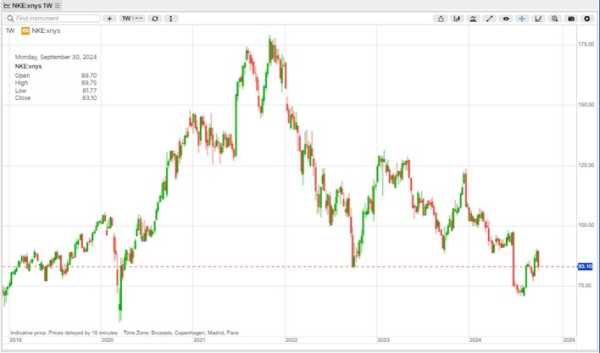
Navigating Nike's volatility with options strategies
With Nike entering a period of uncertainty following its earnings report and leadership transition, the stock’s recent movements present various possibilities for investors with different outlooks. Whether one remains optimistic about the company's long-term prospects or harbors concerns about its immediate future, options strategies offer flexibility in navigating such volatility. By using options, investors can position themselves for a range of potential outcomes—whether it’s acquiring shares at a preferred price, generating additional income, or seeking protection against further downside. The following strategies outline ways in which options can be used to align with varying market expectations and investment goals.
Important note: the strategies and examples provided in this article are purely for educational purposes. They are intended to assist in shaping your thought process and should not be replicated or implemented without careful consideration. Every investor or trader must conduct their own due diligence and take into account their unique financial situation, risk tolerance, and investment objectives before making any decisions. Remember, investing in the stock market carries risk, and it's crucial to make informed decisions.
Long call (LEAPS) strategy: January 2026 call, $65 strike
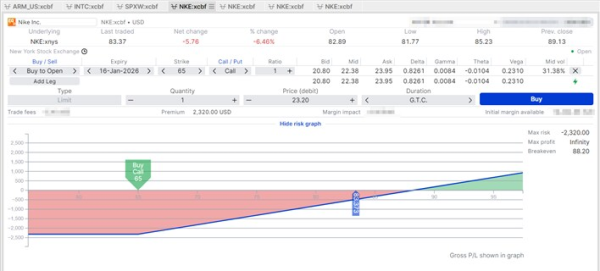
A long call option, specifically a LEAPS (long-term equity anticipation security) contract, allows investors to control 100 shares of Nike with a significantly smaller upfront investment than purchasing the stock outright. LEAPS are simply options with expiration dates far into the future—usually one year or more—offering investors a longer time horizon to capitalize on potential price movements.
In this case, the investor is buying a call option with a strike price of $65, expiring in January 2026. The cost to open this position is $2,320.
- Max risk: $2,320 (the premium paid for the option)
- Max profit: Unlimited (as the stock can rise indefinitely)
- Break-even price: $88.20 (strike price + premium paid)
This option has a delta of 0.8261, meaning that for every $1 move in Nike's stock price, the option’s price will move by approximately $0.83. For example, if Nike's stock rises by $10, the option price would increase by $8.26, bringing the option’s value from $23.20 to $31.46. However, this works both ways: if the stock price falls, the option price will decrease accordingly.
Similarly, if you have a long-term bearish outlook on Nike, you could buy a LEAPS put option. A LEAPS put would allow you to capitalize on a downtrending stock by increasing in value as the stock price declines.
This strategy is suitable for investors who are bullish on Nike's long-term prospects but want to use leverage to increase potential returns. By using this LEAPS call, investors can participate in Nike's upside while limiting their maximum risk to the premium paid.
Covered call strategy: November 2024 call, $87 strike
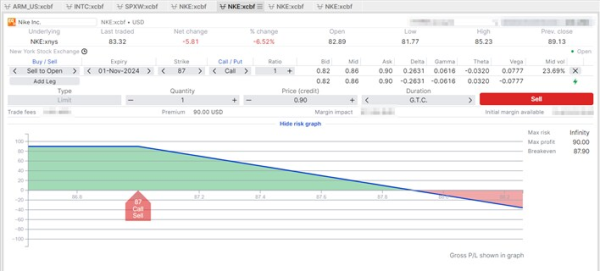
In a covered call, you sell a call option on stock you already own. This strategy generates income from the premium received, while limiting the upside if the stock rises above the strike price. In this case, you sell a call with a strike price of $87, expiring on November 1, 2024, and receive a premium of $0.90 per share (or $90 total for 100 shares).
- Premium received: $0.90 per share ($90 total for 100 shares)
- Max profit: $90 (premium received) + any stock gains up to the strike price of $87.
- Break-even price: $87.90 (strike price + premium received)
- Max risk: The stock can fall, but the premium received provides a small buffer.
Yield on investment:
Though $0.90 per share may not seem like much, it’s more than 1% of Nike’s current stock price of around $83, earned in less than a month. If you could repeat this strategy every month, that’s over 12% in annualized extra income—significantly boosting your returns.
Strategy suitability:
This strategy is ideal for investors who are neutral to moderately bullish on Nike. It provides additional income on your holdings and offers a slight cushion in case of price drops, though it does limit upside if the stock rallies above $87.
Selling an in-the-money put to acquire stock at a discount: October 2024 put, $85 strike
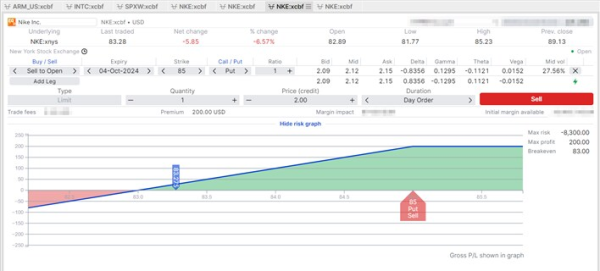
For investors who see Nike's current stock price drop as an opportunity to buy shares at a lower price, selling an in-the-money put option can be a strategic approach. In this case, selling an $85 strike put, expiring on October 4, 2024, can help you acquire shares at a discount compared to the current market price.
- Premium received: $2.00 per share ($200 total for 100 shares)
- Break-even price: $83.00 (strike price of $85 minus the premium received of $2.00)
- Max profit: $200 (premium received)
- Max risk: The stock could drop further, and you'd be obligated to buy 100 shares at $85, but with the premium collected, your effective purchase price is $83.00.
How this strategy works:
By selling this put, you’re obligating yourself to buy Nike stock if it falls below $85 by expiration. In return, you collect a $200 premium immediately, which lowers your effective purchase price to $83.00—slightly below Nike’s current price of $83.28. This provides two possible outcomes:
- Stock stays above $85: If Nike’s stock price remains above $85 by October 4, the put option expires worthless, and you keep the $200 premium as profit.
- Stock falls below $85: If Nike falls below $85, you will be obligated to purchase the stock at that price. However, factoring in the premium received, your effective cost will be $83.00—giving you the opportunity to acquire the shares at a discount.
Why it can be profitable:
- Compared to buying stock directly: Instead of purchasing Nike shares outright at $83.28, selling this put lets you potentially acquire the stock for an effective price of $83.00, plus you keep the premium if the stock price doesn’t fall below $85.
- Generate income: Even if the stock doesn't drop below $85, you keep the $200 premium, providing a return of over 2% on the put in just a short time frame.
Strategy suitability:
This strategy is ideal for investors who want to acquire Nike shares at a lower price but are also comfortable receiving some income (via the premium) while waiting for the stock to drop. It's a more strategic way to build a position at a potential discount, while also earning a premium that boosts overall returns.
Collar strategy: January 2025 call, $90 strike / put, $70 strike
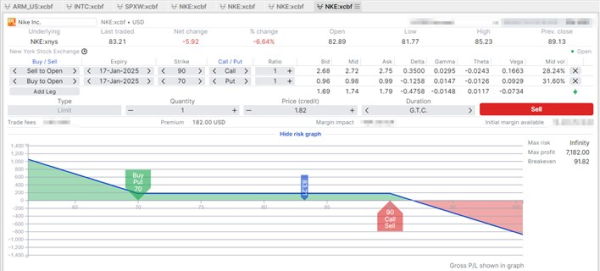
The collar strategy is a conservative options strategy designed to protect investors who already own shares of Nike but are uncertain about future price movements. It involves selling a call and buying a put simultaneously, providing downside protection while limiting upside gains. In this example, the investor sells a $90 strike call and buys a $70 strike put, both expiring on January 17, 2025.
- Premium received: $1.82 per share ($182 total for 100 shares)
- Protection level: Downside protection starts below the $70 strike price (thanks to the put option).
- Max profit: $7182 (based on the upside being capped at the $90 strike price of the call sold).
- Max risk: Your downside is protected starting at $70, and while the strategy window shows "infinity" risk, that's because it doesn’t account for the Nike shares you already own. If you hold 100 shares for each contract, your risk is capped.
How this strategy works:
- Stock appreciation limited at $90: If Nike’s stock price rises above $90 by expiration, your upside is capped. You’d be forced to sell your shares at $90, but you still keep the premium received.
- Downside protection at $70: If Nike’s stock falls below $70, the put option starts to provide protection. You have the right to sell the stock at $70, limiting any further downside.
- Neutral impact: In this case, the premium collected from selling the call ($2.75) is larger than the premium paid for the put ($0.99), meaning you get "free" protection with a net credit of $182.
Why it can be profitable:
- Free downside protection: The net credit from this trade ($182) effectively provides you with cost-free downside protection. You collect the premium for the call, which more than covers the cost of buying the put, giving you a safety net without any out-of-pocket cost.
- Upside is capped: While you have protection on the downside, your upside is capped at $90. This is suitable for investors who are comfortable with limited gains while ensuring protection against major declines.
Strategy suitability:
This strategy is ideal for investors who already own Nike stock and are looking for downside protection without paying additional premiums. It’s a great fit for those who are uncertain about near-term price movements but want to maintain their position with a buffer against losses, while being open to selling their shares at a higher price.
Conclusion
Nike’s recent earnings report and the company’s leadership transition have created both uncertainty and opportunity for investors. Whether you’re bullish, neutral, or bearish on Nike’s future, options strategies provide a range of tools to navigate this volatility. From LEAPS for long-term growth, to covered calls for income generation, selling puts for discounted entry points, or collars for protection, there’s a strategy for every outlook. By carefully selecting the right options approach, investors can enhance their portfolio's returns or hedge against potential risks, all while maintaining flexibility in their investment decisions.| Check out these guides and case studies: |
|---|
| In-depth guide to using long-term options for strategic portfolio management Our specialized resource designed to learn you strategically manage profits and reduce reliance on single (or few) positions within your portfolio using long-term options. This guide is crafted to assist you in understanding and applying long-term options to diversify investments and secure gains while maintaining market exposure. |
| Case study: using covered calls to enhance portfolio performance This case study delves into the covered call strategy, where an investor holds a stock and sells call options to generate premium income. The approach offers a balanced method for generating income and managing risk, with protection against minor declines and capped potential gains. |
| Case study: using protective puts to manage risk This analysis examines the protective put strategy, where an investor owns a stock and buys put options to safeguard against significant declines. Despite the cost of the premium, this approach offers peace of mind and financial protection, making it ideal for risk-averse investors. |
| Case study: using cash-secured puts to acquire stocks at a discount and generate income This review investigates the cash-secured put strategy, where an investor sells put options while holding enough cash to buy the stock if exercised. This method balances income generation with the potential to acquire stocks at a lower cost, appealing to cautious investors. |
| Case study: using collars to balance risk and reward This study focuses on the collar strategy, where an investor owns a stock, buys protective puts, and sells call options to balance risk and reward. This cost-neutral approach, achieved by offsetting the cost of puts with the premiums from calls, provides a safety net and additional income, making it suitable for cautious investors. |
| Previous "Investing with options" articles |
|---|
|
| "Saxo Options Talk" podcast |
|
| Other related articles |
|
| Why options strategies belong in every trader's toolbox |
| Understanding and calculating the expected move of a stock ETF index |
| Understanding Delta - a key guide for Investors and Traders |
|
Options are complex, high-risk products and require knowledge, investment experience and, in many applications, high risk acceptance. We recommend that before you invest in options, you inform yourself well about the operation and risks. In Saxo Bank's Terms of Use you will find more information on this in the Important Information Options, Futures, Margin and Deficit Procedure. You can also consult the Essential Information Document of the option you want to invest in on Saxo Bank's website.